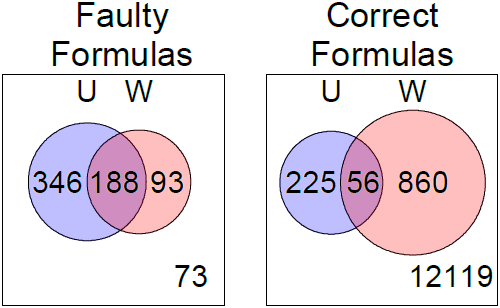Authors
Joseph Lawrance, Robin Abraham, Margaret Burnett, & Martin Erwig
Abstract
Although researchers have developed several ways to reason about the location of faults in spreadsheets, no single form of reasoning is without limitations. Multiple types of errors can appear in spreadsheets, and various fault localization techniques differ in the kinds of errors that they are effective in locating.
In this paper, we report empirical results from an emerging system that attempts to improve fault localization for end-user programmers by sharing the results of the reasoning systems found in WYSIWYT and UCheck.
By evaluating the visual feedback from each fault localization system, we shed light on where these different forms of reasoning and combinations of them complement — and contradict — one another, and which heuristics can be used to generate the best advice from a combination of these systems.
Sample

The Venn diagrams illustrate how often UCheck (U), WYSIWYT (W), and their combinations shaded faulty formulas and correct formulas.
The intersection of UCheck and WYSIWYT corresponds to the formulas shaded by Combo Min, whereas the union of UCheck and WYSIWYT corresponds to the formulas shaded by Combo Max.
Only 73 faulty formulas were not shaded by either system; in contrast, 12119 correct formulas were not shaded by either system.
Publication
2006, Visual Languages and Human-Centric Computing, September, pages 35-42
Full article
Sharing reasoning about faults in spreadsheets: An empirical study
